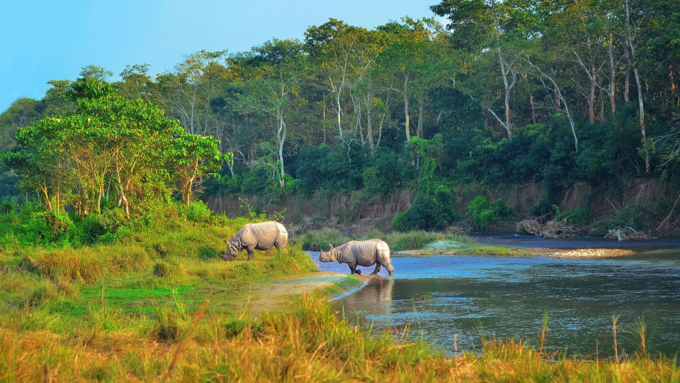If you’re asked to do a piece of descriptive writing, it can be daunting. Where do you start?
Follow these easy steps and you’ll soon get into the habit of what to do.
We’re going to work through an example using a photo as a prompt.

1. Write a list of what you see.
Our eyesight tends to be our strongest sense, so let’s start here. What ‘things’ can you see in this picture? Let’s list the nouns.
Sky, trees, river, rhinos, grass, moss.
2. Add adjectives to describe them.
Now let’s think of one or two interesting adjectives to describe each of these nouns.
For example, cloudless sky, spindly trees, inky river etc.
3. Imagine what you might hear.
In real life, we use all of our senses to process the world around us. So, when we write, we need to do that too. This is so that your reader can get the full experience of what you’re describing, helping them to imagine the scene as if they were actually there.
4. Imagine what you might smell.
This can be a trickier one. It’s not always easy to describe smell. Saying something smells ‘nice’ doesn’t really tell us anything. Here are a few words for smell you might use. See if you can look up some more:
Earthy, damp, fresh, fragrant, musty, mouldy, rotten, foul.
5. What textures can you describe?
When I look at this picture, I see some dry, spiky grass and some soft, spongy moss on the river bank. What else can you spot?
6. What is happening in this picture?
Write some verbs to describe what is going on in this scene. Are the rhinos plodding? Is the river rushing? Or trickling?
7. Now write some descriptive sentences.
Descriptive writing makes full use of writing techniques that really help bring the image to life in the reader’s mind. This is called imagery and the techniques you might use include similes, metaphors, alliteration and personification. Try to do one sentence for each of these techniques.
8. Write some extended noun phrases by putting together what you’ve already found.
To write an extended noun phrase, think about this:
Pick a noun from your list and the adjectives that go with it. Now think about how that noun fits in to the scene, for example, where it is or what it’s doing and add this on to the sentence in the form of a preposition (i.e. ‘on the…’ ‘in the…’ ‘next to the…’). Finally, add another appropriate noun to this sentence with its adjective(s).
Here’s an example:
The inky river meandered through the dense forest.
Now, you have everything you need and you’re ready to put your descriptive piece together. But where do you start?
One idea is to pick a point in the scene and work your way clockwise around it from there. For example, you could start at the sky, then move to the forest, the river, rhinos and then the river bank, Another is to start in the middle and work outwards.
Think about what time of day it might be. Is it the start of a new day when everything is just waking up and coming to life? Or is it the end of the day when things are starting to wind down?
Once you’ve written your first draft, go over it and check against the notes you’ve made to make sure you’ve included everything. A good way to edit your work is to read it out loud. Your brain can miss things that your mouth can’t and you’ll find you stumble over words or sentences that aren’t quite right or need a little work.
Good luck!
For more writing practice, see the rest of the blog.


0 Comments